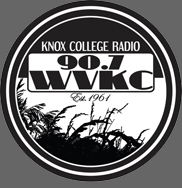 Knox College in Galesburg, Illinois has announced that it will be moving its student radio programming off of 90.7 FM in order to provide space for regional public radio network, Tri States Public Radio (TSPR). Beginning next month, long-time student radio station WVKC will broadcast online and on HD radio. A statement on the Knox College website explains,
Knox College in Galesburg, Illinois has announced that it will be moving its student radio programming off of 90.7 FM in order to provide space for regional public radio network, Tri States Public Radio (TSPR). Beginning next month, long-time student radio station WVKC will broadcast online and on HD radio. A statement on the Knox College website explains,
“WVKC’s main FM signal will carry NPR and other national and regional public radio programming from TSPR. New equipment will be installed at the College station to create a second channel, using HD Radio technology. The second channel will broadcast Knox student programming to any receiver with HD capability.
Knox student programming also will be streamed live on the Internet… additional new equipment will make WVKC’s Internet streaming much more reliable than it has been in the past.
The agreement, expected to take effect in mid-September, builds on an earlier pact with TSPR that has allowed WVKC to carry NPR news programming on weekday mornings.”
When this arrangement was first announced in May, there were indications of support from the student community. An editorial in campus newspaper The Knox Student argued,
“We believe this proposed change will help bring WVKC more in line with listeners’ tendencies. Analog radios are a rarity, and to the extent that we rely on the Internet, this change may help WVKC grow its listenership among the student body.
As President Teresa Amott pointed out in an interview with TKS, we’re getting ahead of the game by making the HD switch, which would have been necessary in a few years regardless. And this way, we’re not footing the bill.”
Despite this positive face, some WVKC participants and listeners are pointing out that HD is not necessarily the future of radio. A May 30 article announcing the changes at the station states that the move would be detrimental for WVKC listeners who only have analog radios. It also quoted a current WVKC General Manager who stated that,
“‘[Some] were sort of making assumptions that no one has an analog and no one listens on analog, which I think, as far as I’m concerned, is not true. Most of the people I know listen on their car radio or have an analog radio, and I think that that assumption should change,’ [Hali] Engelman said.”
In a comment posted to that article, former WVKC staff member Matt Baker argues that HD is not the future of radio. He writes,
“HD radio is dead…It is not the future, it is not ‘ahead of the curve’, and it will not provide WVKC with opportunities. What it _will_ do is decrease listenership, put another wall between Knox and the community, and destroy one of Knox’s best assets*.
Analog radios, despite the editorial staff’s opinion, are not a rarity. They represent an existing broadcast mechanism that Knox uses to serve the *majority* of the public. We’re willing to sacrifice this to get a free upgrade to a new mechanism that serves a *minority* of the public. Knox justifies this because it will allow the school to ‘get ahead of the curve’, when every indication points to the inevitable death of the HD radio format TSPR is so excited to switch us to.
In short, we’re about to give up 90.7 so TSPR can move us to the Betamax of radio.”
Despite this comment, there doesn’t appear to be much overt opposition to these changes at WVKC. The May 2013 article in The Knox Student said, “[Knox College President Teresa] Amott insisted that student opposition would have caused the venture to have been reconsidered.”
Over the years, radio has existed in many different forms at Knox College. The school’s first radio station, WFBZ operated over AM in the 1920s. AM carrier current station WKC followed in the 1940s and the WVKC FM FCC license was obtained in 1961. According to a March, 1925 issue of Radio Age,
“Dreams of the undergraduate members of a little class in radio at Knox College at Galesburg, Illinois, of establishing a Class ‘A’ broadcasting station were fulfilled during February as a result of their own efforts when WFBZ, the Siwash station, took the air for the first time and broadcast a Knox-Monmouth basket ball game to nearby States with an outfit costing but $175, which made a good showing within a radius where there were many stations costing from $10,000 to 860,000 sending forth their programs.”
Reports from 1927 indicate that the 50 watt station, WFBZ, was operating at 1210 AM. In recent years WVKC has garnered press for its ranking in the Princeton Review’s list of the “most popular” radio stations in the country, indicating that many students are aware of the station’s presence on campus.


